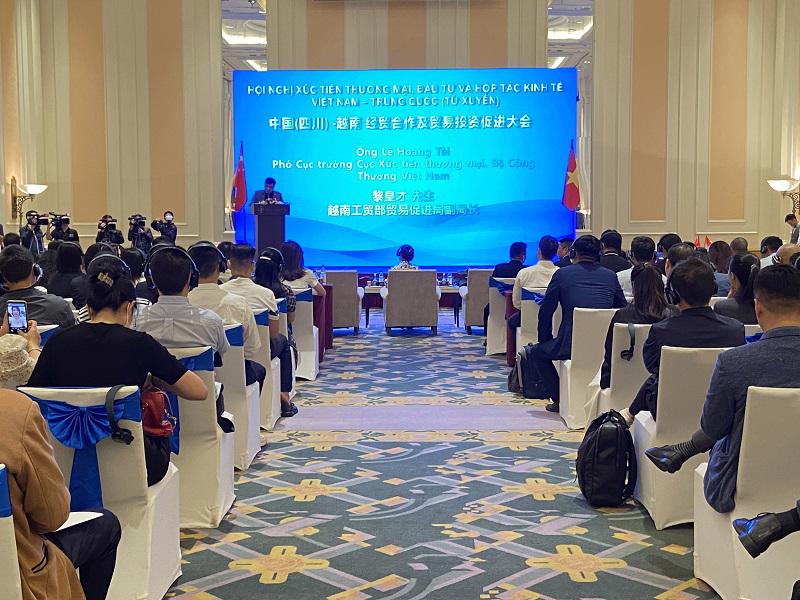[ad_1]
On April 3, the Trade Promotion Department of the Ministry of Industry and Trade, in coordination with the Sichuan Trade Promotion Commission (CCPIT), organized a “Vietnam-China Trade Promotion, Investment and Economic Cooperation Conference” (Sichuan).
Bilateral DIAMOND IS VERY modest
At the conference, Deputy Director of the Department of Trade Promotion Le Hoang Tai said that despite many negative impacts from the Covid-19 pandemic, Vietnam-China economic and trade cooperation is still not strong enough.
According to Vietnam Customs statistics, Vietnam’s total import-export turnover with China will reach US$175.6 billion in 2022, up 5.5% from the same period in 2021. China remains a partner and Vietnam’s largest trade and import market.
In recent years, Vietnam-China (Sichuan) cooperation has been continuously deepening and expanding in many fields by making good use of the advantages of cooperation between the two countries created by the “Vietnam Trade and Development Agreement” Comprehensive Economic Partnership (RCEP) and the China-Vietnam Intermodal Railway Link.
Many large companies in Sichuan Province have invested in Vietnam and actively contributed to the economic development of places in Vietnam. Vietnam – China (Sichuan) not only adheres to economic and trade exchanges, but also intensively cultivates personal exchanges, cultural exchanges and high-level visits.
Despite this, the representative of the Department of Trade Promotion frankly, despite an important position, role and potential market with a population of about 84 million people, but the economic and trade cooperation between Sichuan and Vietnam is still not commensurate with the potential of the two sides.
In 2022, the trade turnover between Vietnam and China (Sichuan) only reached over USD 11 billion, accounting for a very modest share of the total trade turnover between Vietnam and China.
In addition, the import and export sales of both sides will decrease by about 20% in 2022 compared to 2021 due to the impact of the epidemic.
“Against the background that the economic and trade cooperation between the two countries Vietnam – China has essentially completely recovered as before the Covid 19 pandemic, it can be seen that there is potential and room for exploitation, the economic and trade policy Exploiting and expanding cooperation between places in Vietnam and Sichuan Province is still very big,” said Mr. Tai.
EXPLAIN CONVENIENT TRANSPORT BENEFITS FOR BOTH PARTIES
At the conference, Ms. Hoang Le, Chairwoman of Sichuan Provincial Trade Promotion Committee (China), said that Sichuan ranks 4th in the autonomous region, 5th in all of China and the largest region in the world. China ranks sixth in terms of economy, with GDP exceeding 4.5 trillion yuan in 2022, an increase of 2.9%, and GDP per capita exceeding USD 10,000. The size of Sichuan Province’s foreign trade in 2022 will reach US$151.1 billion, up 2.7% from 2021.
This proves that Sichuan has a very special geographic location and enormous economic potential.
Statistics from the Sichuan Provincial Bureau of Statistics show that the import and export turnover between Vietnam and Sichuan Province reached about US$11.3 billion, accounting for 7.4% of Sichuan Province’s total import and export turnover. Vietnam is Sichuan Province’s largest trading partner among the ASEAN countries.

In addition, Ms. Hoang Le said that Sichuan has an important position in strategic planning for the development of China’s key regions, such as the “Belt and Road Initiative,” “River Economic Belt,” Truong Giang, located on the new International Land-sea transport route, the “Song Thanh” strategy (Chongqing – Chengdu), China – Europe Railway. Thus, Sichuan plays a role in connecting China’s interior with neighboring Southeast Asian countries, including Vietnam.
In addition, it is convenient for transportation. The railway line between Chengdu – Trung Khanh to Europe has just opened but has brought great efficiency. Sichuan has more than 2 international airports, opening more than 130 international routes. “So now we have the Silk Road in the air, so the connection between countries will be close,” said the chairman of Sichuan Provincial Trade Promotion Committee.
Mr. Le Hoang Tai added that on April 18, 2022, China opened the first freight train from Chengdu to Hanoi, Vietnam. It is the Shuangliu (Song Luu) train – a model of international air-rail transport. The opening of the Chengdu (Shuangliu)-Hanoi freight train will further improve western China’s air, sea and land transportation network, help companies make the most of RCEP’s opportunities, and strengthen the international trade link between China (Sichuan) and ASEAN countries in general and Vietnam in particular.
On June 11, 2022, the ASEAN Vietnam – China (Sichuan) cross-border high-speed road transport route was opened to two-way traffic to support the construction of a land-sea intermodal transport corridor. New in western China.
Next, on September 29, 2022, China launched a direct transport train from Chengdu to Dong Dang Railway Station, Lang Son, Vietnam, opening a new, safe and fast international logistics channel to transport goods from Sichuan to the ASEAN countries including Vietnam.
“Therefore, Sichuan Province (China), with a large population and strengths in tourism, heavy industry, manufacturing, mining and modern transportation facilities, has been and remains a potential partner of many places in Vietnam in many areas of cooperation,” emphasized Mr. Le Hoang Tai.
Ms. Hoang Le said, “Hopefully, cooperation between the two sides will become more practical. This is also an opportunity for the two countries to start a new chapter, a new phase of better and more effective cooperation. The two sides must try to work together more so that products can penetrate each other’s markets and reach consumers in both countries.”
At the same time, she suggested, the Vietnamese side should organize more trade and investment promotion activities so that Vietnamese companies can pay more attention to and learn more about the Sichuan market. Fostering connectivity across multiple platforms, creating many collaborative opportunities for companies of the two countries.
[ad_2]
Source link

